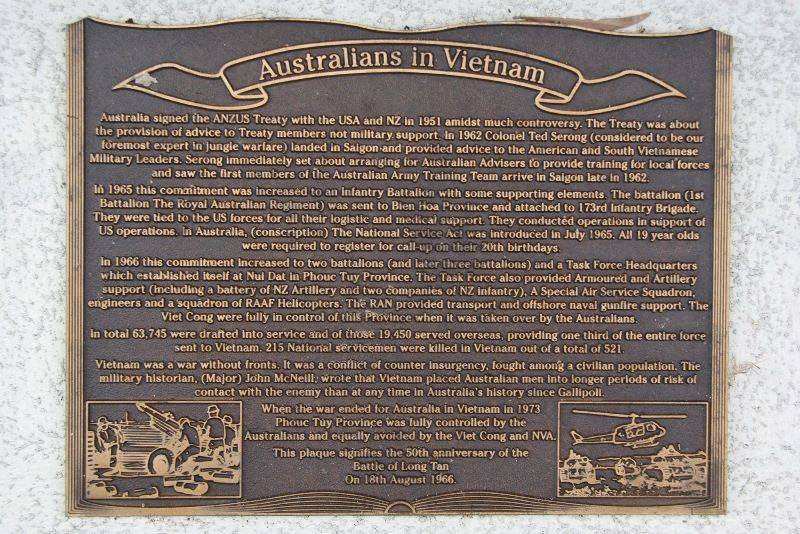
Australians in Vietnam Print Page 

The plaque commemorates Australians who served in the Vietnam War and signifies the 50th anniversary of the Battal of Long Tan on the 18th August 1966.
Australia's military involvement in the Vietnam War began with the arrival of the Australian Army Training Team Vietnam (AATTV) in South Vietnam during July and August 1962. Australia's participation in the war was formally declared at an end when the Governor-General issued a proclamation on 11 January 1973.
However, the end-date of Australia's involvement in the Vietnam War has officially been amended to 29 April 1975 to reflect Australia’s further involvement in the war during the fall of Saigon in 1975. The Department of Veterans Affairs and the Australian War Memorial, in Canberra now recognise this new date.
Location
| Address: | 11 Murphys Road, Wommin Bay Memorial Walk, Kingscliff, 2487 |
|---|---|
| State: | NSW |
| Area: | AUS |
| GPS Coordinates: | Lat: -28.234409 Long: 153.565574 Note: GPS Coordinates are approximate. |
Details
| Monument Type: | Plaque |
|---|---|
| Monument Theme: | Conflict |
| Sub-Theme: | Vietnam |
| Link: | http://www.warmemorialsregister.nsw… |
Dedication
| Actual Monument Dedication Date: | Wednesday 10th August, 2016 |
|---|
Australians in Vietnam
Australia signed the ANZUS Treaty with the USA and NZ in 1951 amidst much controversy. The Treaty was about the provision of advice to Treaty members not military support. In 1962 Colonel Ted Serong (considered to be our foremost expert in jungle warfare) landed in Saigon and provided advice to the American and South Vietnamese military leaders. Serong immediately set about arranging for Australian Advisers to provide training for local forces and saw the first members of the Australian Army Training team arrive in Saigon in late 1962.
In 1965 this committment was increased to an Infantry Battalion with some supporting elements. The battalion (1st Battalion The Royal Australian Regiment ) was sent to Bien Hoa Province and attached to the 173rd Infantry Brigade. They were tied to the US forces for all their logistic and medical support. They conducted operations in support of US operations. In Australia (conscription) The National Service Act was introduced in July 1965. All 19 year olds were required to register for call-up on their 20th birthday.
In 1966 this committment increased to two battalions (and later three battalions) and a Task Force Headquarters which established itself at Nui Dat in Phouc Tuy Province. The Task Force also provided Armoured and Artillery support (including a battery of NZ Artillery and two companies of NZ Infantry), A Special Air Service Squadron, engineers and a squadron of RAAF helicopters. The RAN provided transport and offshore naval gunfire support. The Viet Cong were fully in control of this Province when it was taken over by the Australians.
In total 63,745 were drafted into service and of those 19,450 served overseas, providing one third of the entire force sent to Vietnam. 215 National servicemen were killed in Vietnam out of a total of 521.
Vietnam was a war without fronts. It was a conflict of counter insurgency, fought among a civilian population. The military historian, (Major) John McNeill, wrote that Vietnam placed Australian men into longer periods of risk of contact with the enemy than at any time in Australia`s history since Gallipoli. When the war ended for Australia in Vietnam in 1973 Phouc Tuy Province was fully controlled by the Australians and equally avoided by the Viet Cong and the NVA.
This plaque signifies the 50th anniversary of the
Battle of Long Tan
on 18th August 1966.



